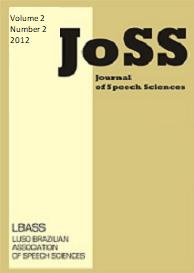Abstract
This study investigates what part the prosodic component plays in linguistic processing. Can prosodic cues be computed early in the linguistic process and influence the syntactic processing? Some studies in American English (Kjelgaard&Speer, 1999; DeDe 2010) and German (Steinhaueret al 1999) have shown that yes, furthermore, prosodic elements like intonational phrases can modify the syntactic chain during processing. Our work is based on the premises that, during the perceptive processing, an early activation of the prosodic component in the linguistic input can lead the sentence’s syntactic structure.There have been studies in Brazilian Portuguese that show how prosody influences parsing (Lourenço-Gomes 2008; Magalhães& Maia 2006), however, none that tested the effects of prosodic constituents’ organization in online tasks.
References
Arantes P. Integrando produção e percepção de proeminências numa abordagem dinâmica do ritmo da fala. [PhD Thesis]. Campinas: UNICAMP; 2010.
Beckman ME, PierrehumbertJB. Intonational structure in Japanese and English.Phonology, 3. 1986: 255-309.
Bever TG. The cognitive basis for linguistic structures. In: Hayes, JR. (ed.). Cognition and the development of language. NY: John Wiley and Sons. 1970: 279-360.
Carlson K, Clifton CJr,Frazier L. Prosodic boundaries in adjunct attachment. Journal of Memory and Language, 45; 2001: 58-81.
Carlson K, Clifton CJr,Frazier L. Informative Prosodic Boundaries.Journal Language and Speech, 45; 2002. p. 87-114.
Carlson K, Clifton CJr,Frazier L. Tracking the what and why of speakers’ choices: Prosodic boundaries and the length of constituents. Psychonomic Bulletin & Review,13 (5). 2006: 854-61.
Carlson K, Frazier L,CliftonCJr. How prosody constrains comprehension: A limited effect of prosodic packaging. Lingua, 119. 2009: 1066-82.
Cuetos F, Mitchell DC.Crosslinguistic differences in parsing: Restrictions on the use of the Late Closure strategy in Spanish. Cognition, 30; 1988: 73-105.
Cunha-Lima ML. Tutorial DMDX. Access: May, 2008. Available in: http://www.letras.ufmg.br/mlcunhalima/DMDX.ppt.
Dancey CP, ReidyJ. Estatística sem Matemática para Psicologia: usando SPSS para Windows. Porto Alegre: ArtmedEditora. 3ª Ed. 2006.
DedeG. Utilization of Prosodic Information in Syntactic Ambiguity Resolution. Journal Psycholinguist Research, 39; 2010: 345–74.
Ferreira F, Henderson JM, Anes MD, Weeks Jr PA, McFarlan DK. Effects of Lexical frequency and Syntactic Complexity in Spoken-Language Comprehension: Evidence from The Auditory Moving-Window Technique. Journal of Experimental Psychology: Learning, Memory and Cognition, 2, 22; 1996: 324-35.
Frazier L. On comprehending sentences: Syntactic parsing strategies. [PhD Thesis].Universityof Connecticut; 1979.
Fonseca AA. A prosódia no parsing: evidências experimentais do acesso à informação prosódica no input linguístico. [PhD Thesis]. Belo Horizonte: UFMG, 2012.
Kimball J. Seven principles of surface structure parsing in natural language.Psychology, 21; 1973: 60-99.
Kjelgaard MM, Speer SR. Prosodic facilitation and interference in the resolution of temporary syntactic closure ambiguity.JournalofMemoryandLanguage, 40; 1999: 153–94.
Lourenço-Gomes MC. Efeito do comprimento do constituinte na interpretação final de orações relativas estruturalmente ambíguas – Um estudo em PB baseado na “Hipótese da prosódia Implícita”. [Master'sThesis]. Rio de Janeiro: UFRJ, 2003.
Lourenço-Gomes MC. Efeitos de segmentação da sentença sobre o processamento. [PhD Thesis]. Rio de Janeiro: UFRJ, 2008.
Magalhães JO, Maia M. Pistas prosódicas implícitas na resolução de ambiguidades sintáticas: Um caso de adjunção de atributos. Revista da Abralin, 5(1), 2006.
Mcrae K, Spivey-Knowlton MJ, Tanenhaus MK. Modeling the Influence of Thematic Fit (and Other Constraints) in On-line Sentence Comprehension.Journal of Memory and Language, 38. 1998: 283–312.
Nespor M, Vogel I. Prosodic Phonology.Foris: Dordrecht, 1986.
Nieuwland MS, Van BerkumJJA.When Peanuts Fall in Love: N400 Evidence for the Power of Discourse. Journal of Cognitive Neuroscience, 18:7. 2006:1098–111.
Pierrehumbert J. The Phonology and Phonetics of English Intonation.[Ph D Thesis].MIT. 1980.
Rayner K, Clifton CJr. Language processing. In: Medin, D. (Volume Editor) Stevens. Handbook of Experimental Psychology: Memory and Cognitive Processes. Third Edition: Volume 2. New York: John Wiley and Sons, Inc. Copyright John Wiley & Sons, Inc. 2002: 261-316.
Speer S, Warren P, Schafer A. Intonation and sentence processing. In: 15th ICPhS. Barcelona, 2003.
Steinhauer K, Alter K, Friederici AD. Brain potentials indicate immediate use of prosodic cues in natural speech processing. Nature Neuroscience, 2 (2), 1999: 191-96.
Tanenhaus MK, Chambers CG, Hanna JE. Referential Domains in Spoken Language Comprehension: Using Eye Movements to Bridge the Product and Action Traditions. In: Herderson JM, Ferreira F (Eds.) The Interface of Language, Vision and Action. New York: Psychology Press, 2004: 279-318.
Vigário M. Prosody and sentence disambiguation in European Portuguese. In: Prieto P. (Ed.) Catalan Journal of Linguistics: Special issue on Romance Intonation, 2. 2003: 249-78.

This work is licensed under a Creative Commons Attribution 4.0 International License.
Copyright (c) 2012 A. A. Fonseca

